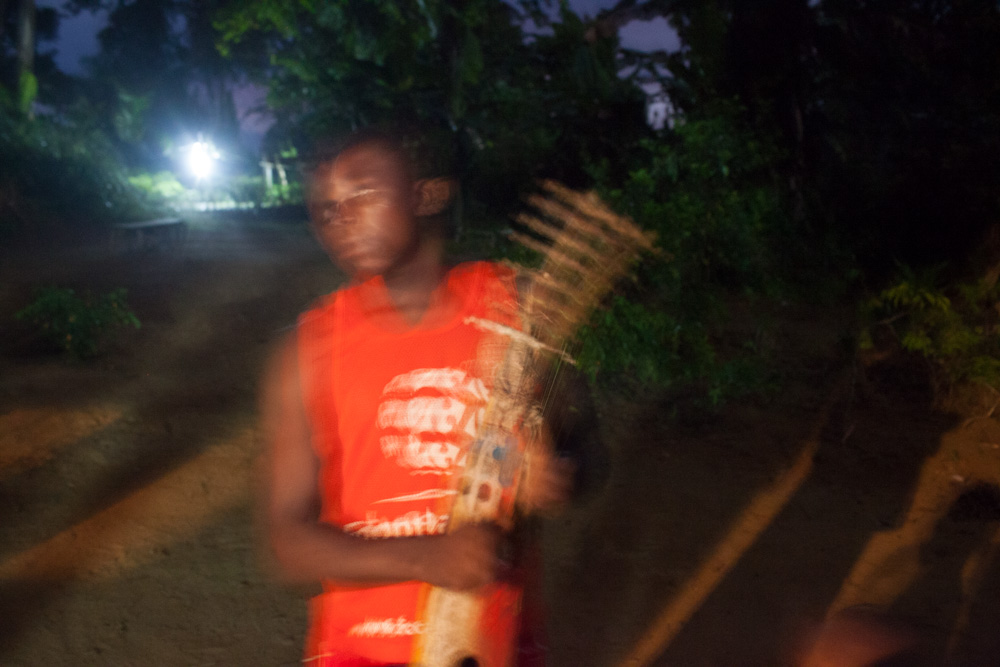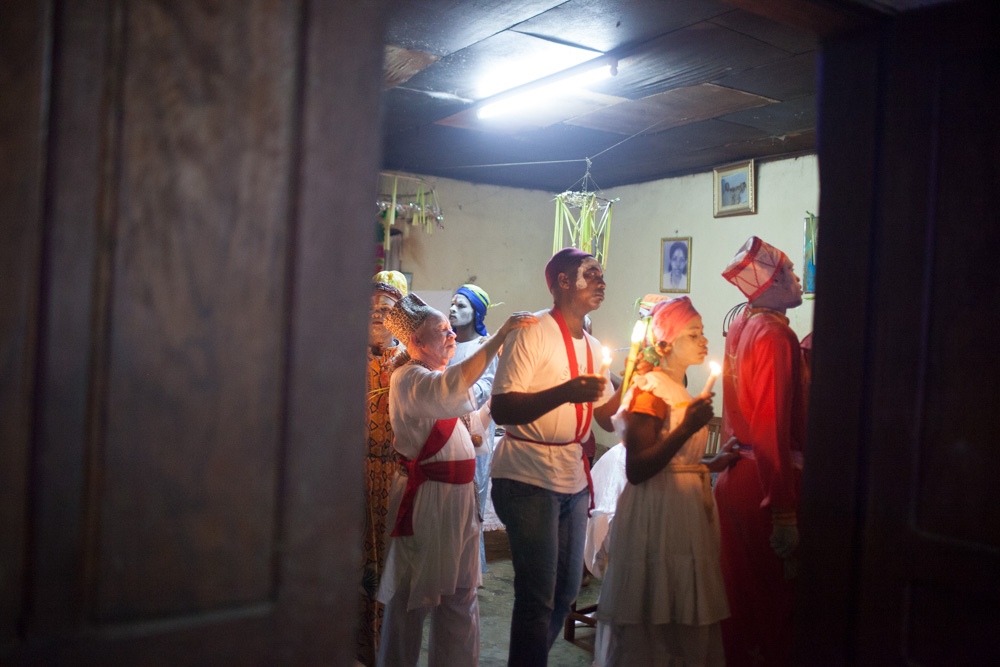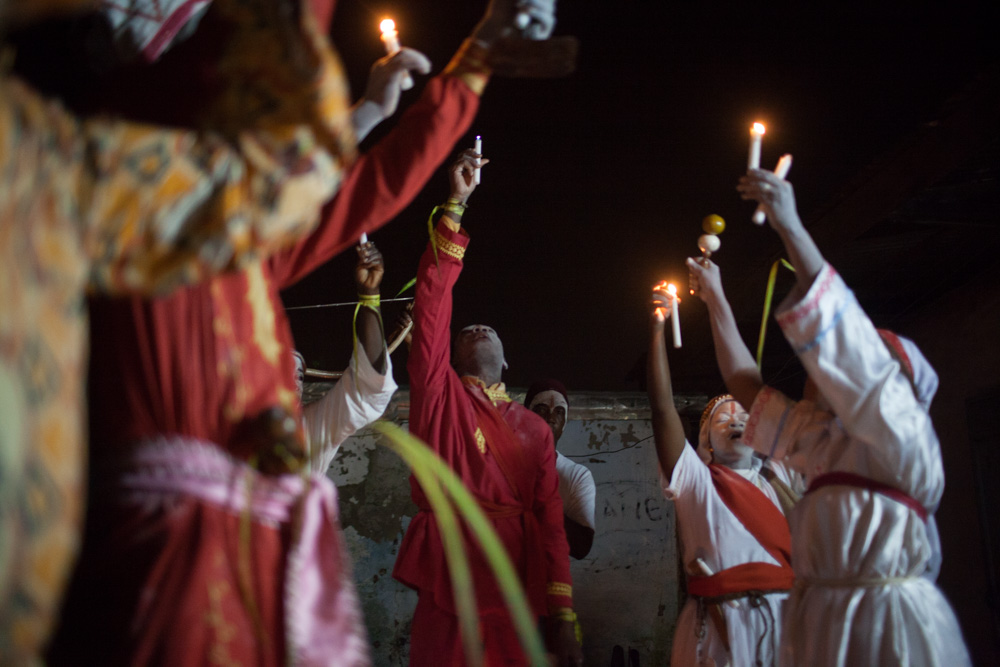How to start, I do not know. The Bwiti tradition is so complex, so full of ambiguities and heterodoxy. Its creation myths, traditions, rituals, all very complex, incoherent, are actually all of secondary importance in relation to the primary experience they offer, experience which is, as many both the most and the least articulate folks admit, is impossible to explain, recount, that can only be lived through the initiation. The experience that is centered around death, reliving all your life in three nights, travelling to other realm, meeting God. Bwiti’s roots reach deep into the rites of first Pygmies, and they belong to the wide African tradition of worship and communication with the ancestors. But in this case, not by symbolic ritual, but through the power of most potent psychedelic on earth, root of iboga.
…
Jak zacząć nie bardzo wiem. Tradycja Bwiti jest tak złożona, tak pełna wieloznaczności i heterodoksji. Jej mity założycielskie, zwyczaje, rytuały, wszystkie bardzo skomplikowane, niespójne, są jednak drugorzędne względem głównego doświadczenia jakie Bwiti oferuje, doświadczenia które, jak zarówno najbardziej jak i najmniej wygadani banzie ( inicjowani ) przyznają, jest nie do przekazania słowami, można je jedynie w inicjacji przeżyć. Doświadczenie które wiąże się ze śmiercią, przeżyciem ponownym całego swojego życia w ciągu trzech nocy, podróżą w zaświaty, spotkaniem z Bogiem. Korzenie Bwiti sięgają głęboko w rytuały pierwszych Pigmejów, i przynależą do wielkiej afrykańskiej tradycji czczenia i komunikacji z przodkami. W tym jednak wypadku nie poprzez symboliczny rytuał, ale dzięki mocy jednego z najpotężniejszych psychodelików na ziemi, korzeniowi ibogi.
But the stories, poetry, songs, symbols tell something and it is through them I will try to present the Bwiti world. I don’t want it to be National Geographic style report, neither my travelogue. Because of this approach this story can be very hermetic, but nobody pays me here to explain the basics, you can easily find them online.. I will feed you allegory and inspiration, story from Africa deserves a good degree of chaos, right?
…
Być może jednak anegdoty, poezja, pieśni, symbole są coś w stanie przekazać i to poprzez nie spróbuję przybliżyć świat Bwiti. Nie chcę aby był to reportaż w stylu National Geographic, kawa na ławę, chodzi o to i o tamto, nie chcę też dziennika podróży zbyt osobistego. Z powodu tego podejścia ta historia może się okazać bardzo hermetyczna, ale nikt mi nie płaci bym tu wyjaśniał podstawy, łatwo je znajdziecie online. Będę tu serwował alegorię i inspirację, opowieść z Afryki musi być nieco mętna, i ze sporą dawką chaosu, prawda?
Ekang Engono describes himself as interested in showing the membership that the world is one thing (dzam da) or a great whole (engura dzam), by showing the connections between things. He offers to tie things together (atsing mam) or coagulate things too much in flux (a lighe mam). He says that Mebege made the world as one thing, “the great egg of the sky spider shows us that, the one hole in the adzap tree shows us that, but people and the world have split into many parts. People have lost their way.” That is to the liking of the witches, for their object is to “isolate men the easier to eat them. When men and the world are all together the witches cannot work.”
p. 496 Fernandez, James W. Bwiti An Ethnography of the Religious Imagination in Africa. Princeton University Press
…
Ekang Engono opisuje się jako zainteresowanego przedstawieniem społeczności że świat jest jedną rzeczą (dzam da) lub jedną całością (engura dzam), poprzez pokazanie powiązań między rzeczami. Oferuje powiązanie ze sobą rzeczy ( atsing mam ), lub skonkretyzowanie zbyt płynnych spraw (a lighe mam). Mówi że Mebege stworzył świat jako jedność, “wielkie jajo niebieskiego pająka pokazuje nam to, jedna dziura w drzewie adzap pokazuje nam to, ale ludzie i świat rozdzielili się w zbyt wiele części. Ludzie stracili kierunek.” To podoba się czarownikom, bo ich celem jest “rozdzielić ludzi aby łatwiej ich zjeść. Kiedy ludzie i świat są jednym, czarownicy nie mogą pracować”
s. 496 Fernandez, James W. Bwiti An Ethnography of the Religious Imagination in Africa. Princeton University Press
(…)the creator God Mwanga. emerges out of the water with earth to form the land. He creates the four sacred trees of Bwiti and plants them in the four corners of the world. He then creates spider to weave a web between these trees and bring them into communication, creating a spidery network and a weaving together of the four corners,
p. 327 Fernandez, James W. Bwiti An Ethnography of the Religious Imagination in Africa. Princeton University Press
…
(…) bóg stworzyciel, Mwanga, wyłania się z wody z ziemią aby uformować krainy. Stwarza cztery święte drzewa Bwiti i sadzi je w czterech zakątkach świata. Potem stwarza pająka aby uwił sieć pomiędzy tymi drzewami, tworząc pajęczą siatkę powiązań i splątując razem ze sobą wszystkie cztery strony,
s. 327 Fernandez, James W. Bwiti An Ethnography of the Religious Imagination in Africa. Princeton University Press
Why is it so, that all psychedelic, each in his own style, whether taken in a flat in Brooklyn by some hipsters, by a sick Indian in the depth of Amazon jungle, or by some Pygmies or simple farmer in the village in Africa always bring the same conclusions about the nature of the world, about unity and interconnectedness? Is the African spider’s web and the Brahmajala, the infinite net of jewels reflecting each other the same reality, revealed ( as in taking off the veil, famous Sufi metaphor ) to different cultures by different techniques? If the exoteric hard-heads in their attachment to diverse forms repulse me from the religion as such, the fruits of the journeys of mystic travelers, all attesting the same, bring hope of the Truth.
…
Dlaczego jest tak, że wszystkie psychodeliki, każdy w swoim stylu, czy to przyjęte w berlińskiej klitce przez znudzonych hipsterów, czy przez chorego Indianina w głębi amazońskiej dżungli, czy przez jakiś Pigmejów czy prostego chłopa w afrykańskiej wiosce, zawsze przynoszą te same wnioski co do natury świata, uczą o jedności i wzajemnym połączeniu wszystkiego? Czy sieć afrykańskiego pająka stworzyciela i Brahmajala, nieskończona sieć klejnotów odbijających się nawzajem to ta sama rzeczywistość, ujawniana przez osłonięcie zasłony iluzji różnym kulturom, przy użyciu różnych technik? Jeżeli egzoteryczni twardogłowi w swym kurczowym czepianiu się swoich różnorodnych i przeciwstawnych nieraz form odpychają mnie od religii, to owoce podróży mistycznych eksploratorów, wszystkie poświadczające to samo, pachną obietnicą Prawdy.








